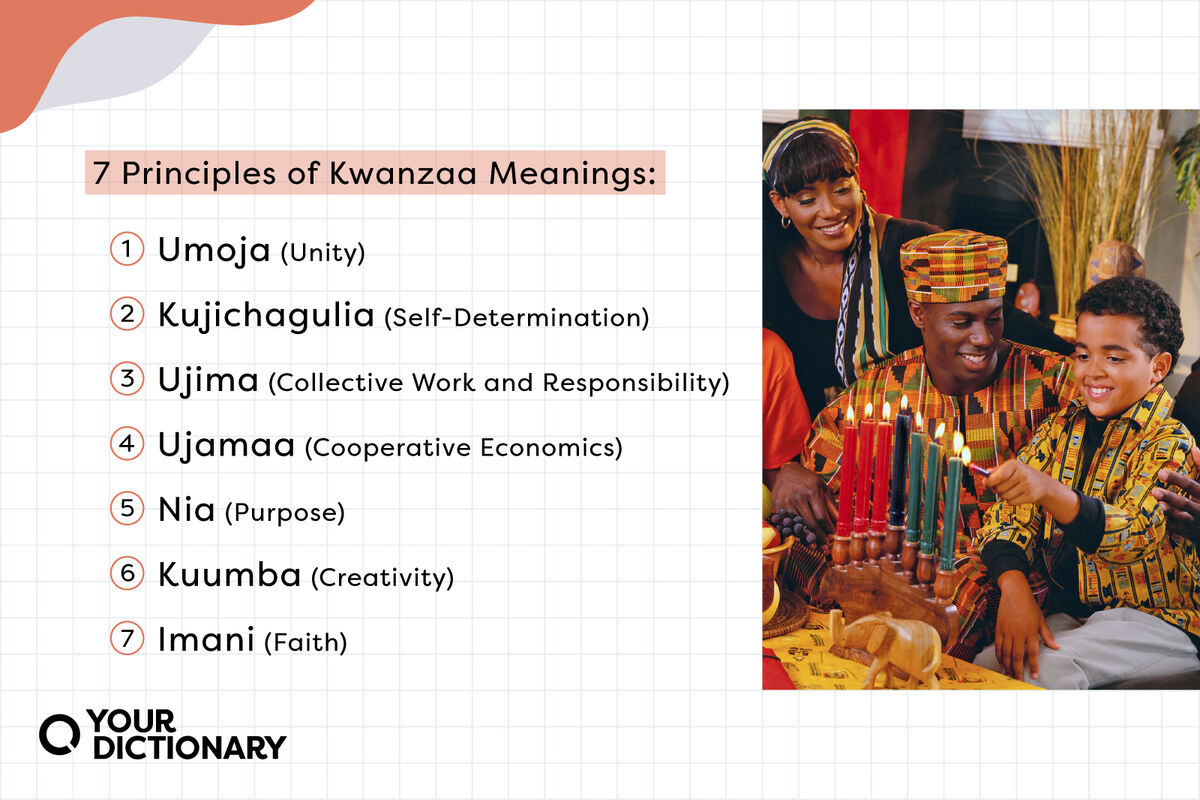
Created by Dr. Maulana Karenga in 1966, Kwanzaa is a joyous celebration of Pan-African culture and community. For some, Kwanzaa is an alternate winter holiday, and for others, it’s in addition to Christmas, Hanukkah, or other celebrations. Either way, it’s a great time for family, friends, and feasting. Kwanzaa centers on seven all-important principles that are worth knowing and practicing even if you don’t celebrate the holiday.
What Does “Kwanzaa” Mean?
The word Kwanzaa (pronounced “KWON-zuh”) comes from the Swahili phrase matunda ya kwanza. This literally translates to “first fruits,” referencing the holiday’s roots in traditional harvest festivals.
While the holiday was initially known as Kwanza, the word was lengthened with a double “A” because Dr. Karenga first taught the festival to seven children, and lengthening the word by one extra letter gave each child their own letter.
Kwanzaa is celebrated every December 26 to January 1. Unlike Christmas and Hanukkah, Kwanzaa is a secular (meaning non-religious) festival. Instead of centering on prayer and religious tradition, Kwanzaa focuses more on African-American culture, community, and family.
What Do the 7 Principles of Kwanzaa Mean?
If you haven’t noticed yet, the number seven holds a lot of power and symbolism in celebrating Kwanzaa: The word has seven letters, the celebration lasts seven days, and the holiday focuses on seven main principles, or Nguzo Saba. These seven principles reinforce African values, and Kwanzaa observers should spend each day of the festival reflecting on one principle.
This is commemorated with the kinara, a seven-branched candelabra. The middle candle is black, three candles on the left are red, and three candles to the right are green. Each day, one of the candles is lit in conjunction with one of the principles.
1. Umoja (Unity)
On the first day of Kwanzaa, members of the African-American community focus on the principle of umoja (pronounced “oo-MOH-juh”). This principle emphasizes the importance of unity in all areas, including family, community, nation, and race.
You light the center black candle in dedication to umoja on day one.
2. Kujichagulia (Self-Determination)
The second principle of Kwanzaa is kujichagulia (pronounced “koo-jee-CHA-goo-LEE-ah”), or “self-determination.” Its focus is building your identity as a person and a community, both historically and in the present day, by asking the question, “Who am I?” Kujichagulia also encourages the question, “Am I all that I ought to be?”
Traditionally, you light the first red candle to the immediate left of the black candle. Note that, although the black candle is always first, the order and color of the other candles will vary based on household traditions and personal choice.
3. Ujima (Collective Work and Responsibility)
Ujima (pronounced “oo-JEE-mah”) focuses on the collective responsibility for both achievements and setbacks in the community. This principle reminds celebrants that building each other up is the best way to truly solve problems.
On the third day, you light the first green candle to the immediate right of the black candle.
4. Ujamaa (Cooperative Economics)
Ujamaa (pronounced “oo-JAH-maa”) is the principle of cooperative economics. This goes beyond the mass spending associated with the holiday season. Ujamaa focuses on a concerted effort to pool resources (financial and otherwise) together to benefit Black communities and neighborhoods and essentially build a more communal sense of “profit.”
On the fourth day, you light the second red candle.
5. Nia (Purpose)
Nia (pronounced “NEE-ah”), which means “purpose,” is the fifth principle of Kwanzaa. Nia can refer to being proactive in setting your own personal goals, but it also encourages you to think outward and look at goals that can benefit the larger community. It can mean purpose for your own future, the financial purpose of your family, or the collective purpose of your economic community.
To commemorate nia, you light the second green candle on the fifth day.
6. Kuumba (Creativity)
Kuumba (pronounced “ko-OOM-bah”) is the principle of creativity. This can, of course, refer to individual creativity, but the focus is on improving and bringing beauty to your community through that creativity, whether it's art, dance, music, or literature.
You light the last red candle for kuumba.
7. Imani (Faith)
On January 1st, the final day of Kwanzaa, celebrants light the last green candle for the principle of imani (pronounced “ee-MAH-nee”). Imani translates to “faith.” Remember that Kwanzaa is a non-religious celebration, but faith here refers to the family and community traditions as a spiritual center. It is a belief in community leaders, teachers, and loved ones, past and present.
Other Words To Help You Celebrate Kwanzaa
Those seven principles are immensely important, but Kwanzaa isn’t just about learning. It’s supposed to be fun! It’s a time for pride and purpose as much as it is a time for goofing around with family and friends. Expanding your vocabulary can help you understand the holiday's roots, so you can celebrate the festival to its fullest and greet friends for Kwanzaa properly.
- bendera - flag with black (for people), red (for struggles), and green (for the future) colors
- Karamu Ya Imani - “feast of faith”; the final feast of the Kwanzaa celebration
- kente - African cloth often worn during Kwanzaa
- Kikombe cha Umoja - unity cup for giving thanks (shukrani) to African ancestors
- mazao - crops to celebrate the harvest of work and productivity
- Mishumaa Saba - seven candles that symbolize the seven principles of Kwanzaa
- mkeka - mat that holds the other Kwanzaa symbols
- muhindi - corn that symbolizes the future of children and descendants
- zawadi - gifts that represent labor, love, and commitment